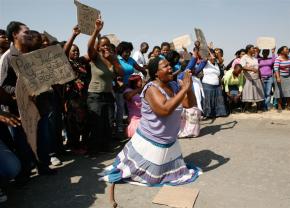A brutal attack on miners
The brutal police killing of at least 34 platinum miners and the wounding of dozens more has shocked South Africa and put a spotlight on exploitation and inequality some two decades after the end of racist apartheid rule.
The workers, who had launched a wildcat strike at the Marikana mine operated by the company Lonmin, were protesting outside the mine when police opened fire with live ammunition. The strikers are members of the Association of Mineworkers and Construction Union (AMCU), a union critical of the National Union of Mineworkers that militant workers say is too collaborative with management.
The massacre--by far the worst state violence since the 1960 Sharpeville massacre carried out by the old white minority regime--came after 10 workers had died in previous clashes. And while police violence in Marikana was extreme, it is part of a years-long pattern of police brutality against activists protesting the policies of the African National Congress (ANC) government over social programs and community services.
As the promises of liberation have faded, South Africa has become the world's most unequal society, with many former leaders of the anti-apartheid and labor movements now ensconced in elite government as well as business circles, thanks to the Black Economic Empowerment policy in which business created a strata of Black capitalists.
Meanwhile, popular and working-class discontent has been mounting for years--and Marikana has now forced a debate over the direction of South African society.
The editorial board of the magazine --the name means "power" in the Zulu language--issued this statement in the wake of the massacre.
NO EVENT since the end of apartheid sums up the shallowness of the transformation in this country like the Marikana massacre. What occurred will be debated for years. It is already clear the mineworkers will be blamed for being violent. The mineworkers will be painted as savages. Yet, the fact is that heavily armed police with live ammunition brutally shot and killed over 35 mineworkers. Many more are injured. Some will die of their wounds. Another 10 workers had been killed just prior to this massacre.
This was not the action of rogue cops. This massacre was a result of decisions taken at the top of the police structures. The police had promised to respond with force and came armed with live ammunition. They behaved no better than the apartheid police when facing the Sharpeville [protesters], the 1976 Soweto uprisings and 1980s protests where many of our people were killed.
The aggressive and violent response to community service delivery protests by the police have their echo and reverberation in this massacre.

This represents a bloodstain on the new South Africa.
This represents a failure of leadership. It is a failure of leadership from government: its ministers of labor and minerals resources who have been absent during this entire episode; its Minister of Police that maintains this is not political but a mere labor dispute and defends the action of the police; a failure of the president who can only issue platitudes in the face of this crisis and not mobilize the government and its tremendous resources to immediately address the concerns of the mineworkers; and now, their bereaved family members.
It has been a failure and betrayal of the Lonmin mine management that refused to follow through on undertakings to union leaders to meet the workers and address their grievances. The management summersaults between agreeing to negotiate with workers and then reneges, saying they have an existing two-year agreement with National Union of Mineworkers (NUM).
It is unfortunately also a failure of the union leadership: In the first instance the NUM which regards any opposition to their leadership as criminal and asserts that such opposition must necessarily be a creation of the Chamber of Mines. This is obviously not true. It is also a failure of the leadership of Association of Mining and Construction Union (AMCU), which acts opportunistically in an effort to recruit disgruntled NUM members, mobilizes workers on unrealistic demands and fails to condemn the violence of its members.
The level of violence on our mines demonstrates the deep divisions within and polarization of South African society. Mineworkers are employed in extreme conditions of poverty, often living in squalor in squatter camps without basic services. The mineworkers are often employed through labor brokers and informalized without decent work conditions.
The "wildcat strike" (like other similar strikes on the mines) that set off the events leading to the slaughter is a response to the structural violence of South Africa's system of mining. However, it is also a response to something else, which we dare not ignore.
Enriched mineowners with the experience of Black Economic Empowerment (BEE) co-option see an opportunity of driving a wedge between "reasonable" union leaders and the workers. They entice the unions into sweetheart relations dividing them from the worker ranks-and-files. The anger on the mines is a deep-seated anger at mine management that is progressively being directed at the compliance and failure of their union leadership to defend and represent worker interests.
The alienation between union members and the unions' leadership is a factor behind what has happened at Lonmin and what is happening on other platinum mines.
Nevertheless, the slaughter of more than 35 mineworkers is as a result of the violence of the state, specifically the police. At the very least, Police Minister Nathi Mthethwa must take responsibility and resign.


